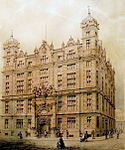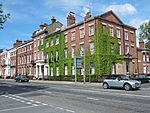Park Lane railway goods station
1830 establishments in EnglandDisused railway goods stations in Great BritainDisused railway stations in LiverpoolFormer London and North Western Railway stationsMerseyside railway station stubs ... and 4 more
Pages with no open date in Infobox stationRailway stations in Great Britain closed in 1972Railway stations in Great Britain opened in 1830Use British English from March 2017

Park Lane was the world's first goods terminus on the Liverpool and Manchester Railway serving the south end Liverpool Docks. The station was opened in 1830. Its initial name was Wapping Station. The goods station was accessed from Edge Hill rail junction in the east of the city via the 1.26 miles (2.03 km) long Wapping Tunnel. The goods station suffered from heavy German air raids during the Second World War, being mostly rebuilt after the conflict. The station along with the Wapping Tunnel was closed in 1972 and subsequently demolished. The tunnel remains intact.
Excerpt from the Wikipedia article Park Lane railway goods station (License: CC BY-SA 3.0, Authors, Images).Park Lane railway goods station
Sparling Street, Liverpool Chinatown
Geographical coordinates (GPS) Address Nearby Places Show on map
Geographical coordinates (GPS)
| Latitude | Longitude |
|---|---|
| N 53.3977 ° | E -2.9855 ° |
Address
Sparling Street
Sparling Street
L1 8JS Liverpool, Chinatown
England, United Kingdom
Open on Google Maps







